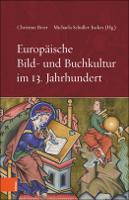| dc.contributor.editor | Christine Beier | |
| dc.contributor.editor | Michaela Schuller-Juckes | |
| dc.date.accessioned | 2021-11-05T04:06:55Z | |
| dc.date.available | 2021-11-05T04:06:55Z | |
| dc.date.issued | 2020 | |
| dc.identifier.uri | https://library.oapen.org/handle/20.500.12657/51312 | |
| dc.description.abstract | European visual culture changed so fundamentally in the 13th century that, in retrospect, we perceive an epochal boundary – the stylistic change from Romanesque to Gothic, the transition from the High to the Late Middle Ages. Some of the foundations for this were laid in the previous century. Thus the developments initiated in the masons' lodges of northern France in the middle of the 12th century not only led to the great architectural achievements of the 13th century, but also to common standards in the sculpture of Western, Central and partly Southern Europe. Another important impulse came with the conquest of Constantinople in 1204. The half-familiar, half-exotic visual media of Byzantine art were mainly received in Central Europe and Italy, leading to the development of specific art forms that were distinct from Western painting. These achievements were complemented by literary production, which took on an unprecedented scale. In addition to the almost boundless quantities of religious writings and specialist literature, mainly written in Latin, the tradition of extensive profane poetry in national languages, which began at the end of the 12th century, intensified. The latter is evidenced by a growing readership outside spiritual institutions and the manufacturing structures that were formed to meet the new demand. This was inevitably accompanied by innovations in book illumination and the creation of new secular picture cycles.
Which of the aforementioned dynamics were decisive in each individual case and whether there were other important factors that contributed to this development was the subject of an international conference that took place in 2017 at the Art History Institute of Vienna University under the title "Image- and Book-Culture in 13th-Century Europe", the results of which are presented in this volume. The contributions approach various aspects of the developments from different angles. They offer a range of current research, including approaches from the history of ideas and media research, as well as findings on recipients, networks, the transfer of objects and technical innovations based on detailed analyses. The starting point is formed by images - paintings and sculptures, stationary as well as mobile, publically accessible as well as private. | |
| dc.language | German | |
| dc.language | English | |
| dc.language | Italian | |
| dc.subject.classification | thema EDItEUR::A The Arts::AG The Arts: treatments and subjects::AGA History of art | en_US |
| dc.subject.classification | thema EDItEUR::6 Style qualifiers::6M Styles (M)::6MB Medieval style | en_US |
| dc.subject.classification | thema EDItEUR::A The Arts::AF The Arts: art forms::AFC Paintings and painting | en_US |
| dc.subject.classification | thema EDItEUR::A The Arts::AF The Arts: art forms::AFK Non-graphic and electronic art forms::AFKB Sculpture | en_US |
| dc.subject.classification | thema EDItEUR::A The Arts::AF The Arts: art forms::AFP Ceramics, mosaic and glass: artworks | en_US |
| dc.subject.other | art history, Europe in the Middle Ages, book painting, sculpture, mosaic | en |
| dc.subject.other | ÖFOS 2012, Art history | en |
| dc.subject.other | Kunstgeschichte, Europa im Mittelalter, Buchmalerei, Skulptur, Mosaik | de |
| dc.subject.other | ÖFOS 2012, Kunstgeschichte | de |
| dc.title | Europäische Bild- und Buchkultur im 13. Jahrhundert | de |
| dc.type | book | |
| oapen.abstract.otherlanguage | Im 13. Jahrhundert veränderte sich die europäische Bildkultur so grundlegend, dass wir im Rückblick eine Epochengrenze wahrnehmen - den Stilwechsel von der Romanik zur Gotik, den Übergang vom Hoch- zum Spätmittelalter. Einige der Voraussetzungen hierfür wurden noch im vorangegangenen Jahrhundert geschaffen, wie die in den nordfranzösischen Bauhütten des mittleren 12. Jahrhunderts eingeleiteten Entwicklungen, die sich in weiten Teilen Europas durchsetzten und im 13. Jahrhundert nicht nur zu großartigen architektonischen Leistungen, sondern auch zu gemeinsamen Standards in der Plastik West-, Mittel- und teils auch Südeuropas führten. Einen weiteren wichtigen Impuls brachte die Eroberung Konstantinopels 1204, in deren Anschluss die halb vertrauten, halb fremden visuellen Medien der byzantinischen Kunst vor allem in Mitteleuropa und Italien verarbeitet wurden und zur Entwicklung einer eigenen, von der westlichen abgrenzbaren Malerei führten. Diesen Leistungen ist die literarische Produktion an die Seite zu stellen, die ein bis dahin unbekanntes Ausmaß annahm: Neben der nahezu unüberschaubaren Zahl überwiegend in Latein verfasster (und damit überregional rezipierbarer) religiöser Schriften und Fachliteratur vor allem für Juristen, aber auch für Ärzte und Astrologen wurde die im ausgehenden 12. Jahrhundert begonnene Tradition umfangreicher profaner Dichtungen in den Landessprachen verstärkt fortgesetzt. Die Zunahme dieser Literatur belegt eine wachsende Leserschaft außerhalb geistlicher Institutionen, und es bildeten sich Herstellungsstrukturen aus, die diesen Bedarf decken konnten. Dass damit Innovationen in der Buchmalerei einhergingen und neue weltliche Bildprogramme geschaffen wurden, ist naheliegend.
Welche der genannten Dynamiken im Einzelfall entscheidend waren, wie sich diese äußerten und ob es weitere wichtige Faktoren gab, die zu dieser Entwicklung beitrugen, war Gegenstand einer international besetzten Tagung, die 2017 im Kunsthistorischen Institut der Universität Wien unter dem Titel „Europäische Bild- und Buchkultur im 13. Jahrhundert“ stattfand und deren Ergebnisse im vorliegenden Band präsentiert werden. Die Beiträge nähern sich der Frage nach den Charakteristiken der Entwicklung aus unterschiedlichen Perspektiven und bieten einen Querschnitt aktueller Forschungen, der sowohl ideengeschichtliche Ansätze wie Emotions- und Medienforschung als auch auf Detailanalysen beruhende Erkenntnisse zu Rezipienten, Netzwerken, Transfer von Objekten und Ideen sowie zur Durchsetzung technischer Innovationen einschließt. Ausgangspunkt sind Bilder - imagines, in gemalter wie plastischer, ortsfester wie beweglicher, massentauglicher wie intimer Form. | |
| oapen.relation.isPublishedBy | af16fd4b-42a1-46ed-82e8-c5e880252047 | * |
| oapen.relation.isFundedBy | 0bdd30b8-28cc-4e2d-bd69-6cabb77b36d4 | |
| oapen.relation.isbn | 9783205211921 | |
| oapen.collection | Austrian Science Fund (FWF) | |
| oapen.grant.number | PUB 719 | |

